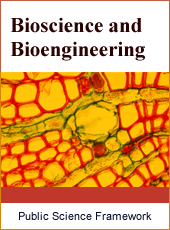Bioscience and Bioengineering
Articles Information
Bioscience and Bioengineering, Vol.2, No.1, Feb. 2016, Pub. Date: Jan. 18, 2016
The Opinion of Palestinian Society in Tulkarm District on Genetically Modified (GM) Crops
Pages: 1-7 Views: 3951 Downloads: 1661
[01]
Nawaf Abu-Khalaf, College of Agricultural Sciences and Technology, Palestine Technical University - Kadoorie (PTUK), Tulkarm, Palestine;Technical and Applied Research Center (TARC), Palestine Technical University - Kadoorie (PTUK), Tulkarm, Palestine.
[02]
Yamen Hamdan, College of Agricultural Sciences and Technology, Palestine Technical University - Kadoorie (PTUK), Tulkarm, Palestine.
The issue of genetically modified (GM) crops becomes recently an important aspect worldwide, and this is due to the food shortage and continuous population increasing. There are confusion and disagreement about using GM crops among different nations globally. GM crops are relatively a new issue in Palestine. To our best knowledge, there is no previous information about the opinion of the Palestinian people about GM crops. The aim of this paper was to screen the opinion of the Palestinian people in Tulkarm district about GM crops. This district will be a first step in screening the opinion of the people in all Palestinian’s districts about GM crops. The research was carried out by distributing a structured questionnaire with 36 questions to 350 persons. The questions implicitly concentrated on three main aspects: perception, strategies for improving public awareness and regulation in the legalization of GM products. Data analysis was carried out using Chi-square tests in Statistical Package for Social Sciences (IBM, SPSS, version 15), and Microsoft Excel 2007 (Microsoft Office, 2007) was used for making graphs. Answers of the questionnaires were examined in their significance differences (p<0.05) with four independents variables (age, gender, education and career). It was found that there is mixing between GM crops and other related concepts. Different media can be used for disseminating GM crops information. However, internet, radio and TV are the most preferred media methods. Further research still needed for making a clear picture of GM crops issue in Palestine.
Genetically Modified (GM) Crops, Local Society, Palestine, Tulkarm, Perception, Awareness, Dissemination
[01]
Ali-Shtayeh, M. S., Jamous, R. M., Al-Shafie, J. H., Elgharabah, W. A., Kherfan, F. A., Qarariah, K. H., and Nasrallah, H. A. (2008). Traditional knowledge of wild edible plants used in Palestine (Northern West Bank): a comparative study. Journal of Ethnobiology and Ethnomedicine, 4: 1-13.
[02]
Arafeh, R. M., Sapir, Y., Shmida, A., Iraki, N., Fragman, O., and Comes, H. P. (2002). Patterns of genetic and phenotypic variation in Iris haynei & I. atrofusca (Iris sect. Oncocyclus = the royal irises) along an ecogeographical gradient in Israel and the West Bank. Molecular Ecology, 11: 39-53.
[03]
Assem, S. K. (2014). Opportunities and challenges of commercializing biotech products in Egypt: Bt maize: A case study. In: Biotechnology in Africa, Emergence, Initiatives and Future, Wambugu, F. and Kamanga, D. (Eds.), Springer International Publishing, 37-51.
[04]
Chen, H., and Lin, Y. (2013). Promise and issues of genetically modified crops. Current Opinion in Plant Biology, 16: 255-260.
[05]
Dudek, C. M. (2015). GMO food regulatory frameworks in the US and the EU. In: The New and Changing Transatlanticism: Politics and Policy Perspectives; Routledge: New York, NY, USA, 214–232.
[06]
Editorial (2013a). Fields of gold, genetically modified crops: promise and reality, Nature, 497: 5–6.
[07]
Editorial (2013b). Fields of gold, genetically modified crops: promise and reality. Nature (Arabic version), 9: 31-33.
[08]
Grunewald, W., Bury, J. and Inze, D. (2013). Biotechnology: Thirty years of transgenic plants, Nature, 497: 40.
[09]
ISF (International Seed Federation) (2011). Agriculture under pressure, http://www.worldseed.org/isf/home.html, accessed on 15 November 2015.
[10]
Jacobsen, S. E., Sorensen, M., Pedersen, S. M., and Weiner, J. (2013). Feeding the world: genetically modified crops versus agricultural biodiversity. Agronomy for Sustainable Development, 33: 651-662.
[11]
Mabaya, E., Fulton, J., Simiyu-Wafukho, S., and Nang'ayo, F. (2015). Factors influencing adoption of genetically modified crops in Africa. Development Southern Africa, 32: 577-591.
[12]
MOA (Ministry of Agriculture) (2010). Agriculture sector strategy - A shared vision 2011-2013. Published by Ministry of Agriculture in Palestine. http://www.lacs.ps/documents Show.aspx?ATT_ID=3991, accessed on 15 November 2015.
[13]
Sakr, M. M. and Ali, H. D. (2011). Egyptians’ opinion in genetically modified foods. Journal of Biotechnology Research (in Arabic), 11: 1-7.
[14]
Sawalha, K., Eideh, H., Laham, S. A., Hasasneh, H., and Mezeid, B. (2008). Genetic diversity studies on wheat landraces in Palestine using RAPD markers in comparison to phenotypic classification. Journal of Applied Biological Sciences, 2: 29-34.

ISSN Print: 2381-7690
ISSN Online: 2381-7704
Current Issue:
Vol. 6, Issue 3, September Submit a Manuscript Join Editorial Board Join Reviewer Team
ISSN Online: 2381-7704
Current Issue:
Vol. 6, Issue 3, September Submit a Manuscript Join Editorial Board Join Reviewer Team
| About This Journal |
| All Issues |
| Open Access |
| Indexing |
| Payment Information |
| Author Guidelines |
| Review Process |
| Publication Ethics |
| Editorial Board |
| Peer Reviewers |


